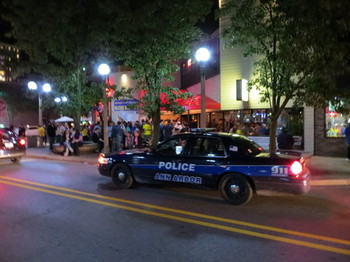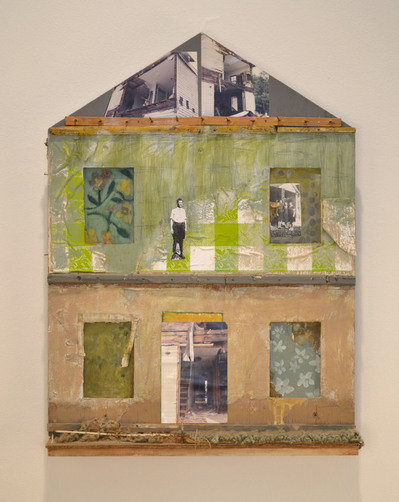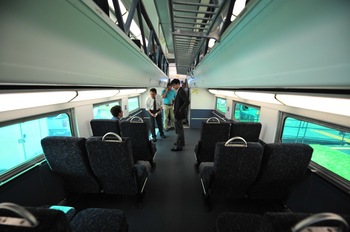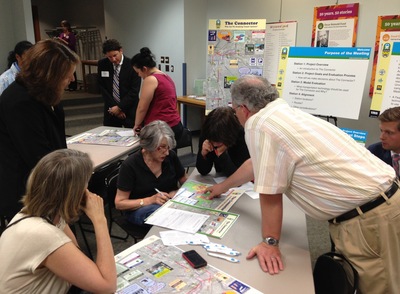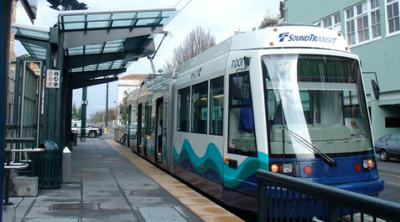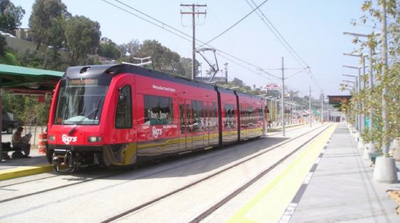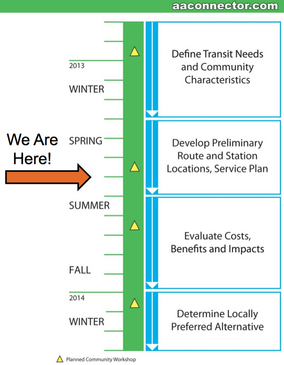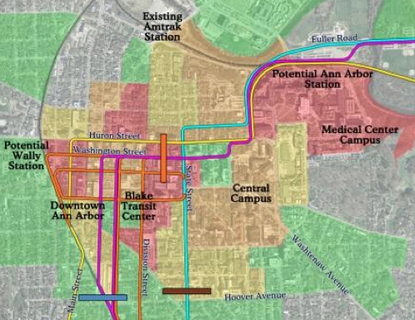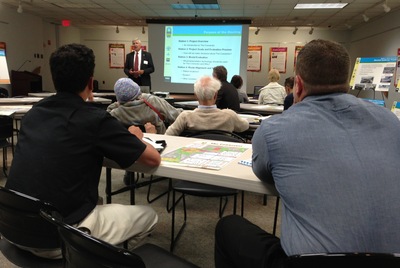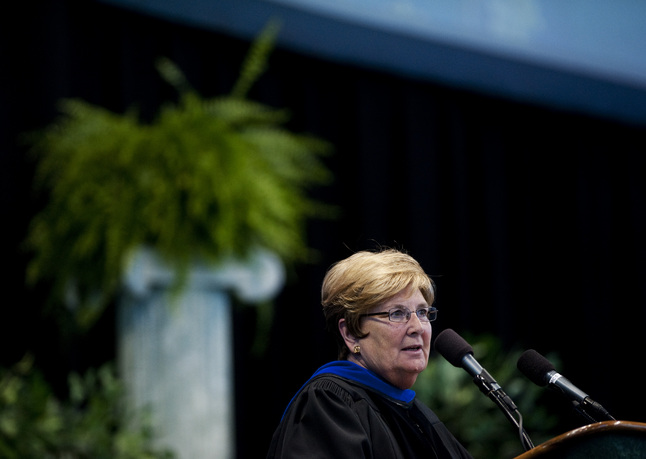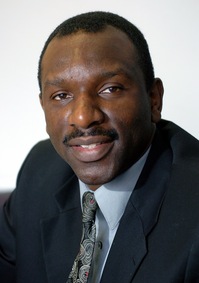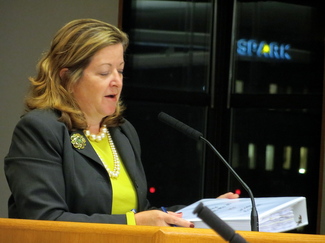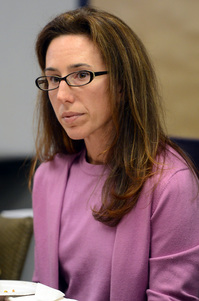The
vision for a high-capacity transit system in
Ann Arbor — either light rail, streetcar or bus rapid transit — is taking shape with preliminary route alternatives now mapped.
Officials behind the Ann Arbor Connector project have released documents showing a series of possible options for connecting some of the city's major activity centers.
![Connector_workshop_061813_RJS_002.jpg]()
Roger Hewitt, a downtown business owner who is representing the Ann Arbor DDA on the Connector steering committee, discusses a map showing preliminary route alternatives with library board member Nancy Kaplan and City Council Member Jane Lumm during a Tuesday evening workshop at the downtown library.
Ryan J. Stanton | AnnArbor.com
Each scenario proposes connecting the University of Michigan's North and Central campuses, while also linking to the university medical center, downtown and Briarwood Mall.
Four partners are involved in the ongoing Connector study: the city of Ann Arbor, Downtown Development Authority, Ann Arbor Transportation Authority and U-M.
The work being done now is aimed at determining possible routes, station locations and a service plan. The next step heading into the fall is to further evaluate costs and benefits.
The process of closely examining different options for the Connector started late last year and is expected to culminate in early 2014 with the selection of a locally preferred alternative, said Rick Nau of URS Corp., project manager for the Connector study.
After the study is completed, there will be a good idea of the costs, Nau said, and the project should be well positioned to receive federal funds for future implementation.
"My assessment at this point is that in Ann Arbor we're talking about a very high level of ridership and a very high potential for travel time savings, so my belief is it would rank very high," he said.
Nau said federal funds have been provided for systems like the proposed Ann Arbor Connector under the Federal Transit Administration's New Starts program.
"That New Starts program provides about 50 percent of the capital costs," he said. "It's a highly competitive program. Cities all across the country compete for these dollars."
While that would be the primary source of federal funding, Nau said, Portland's streetcar system, for example, was funded by about a dozen different sources ranging from parking revenues to tax-increment financing to state air quality mitigation funds.
![Tacoma_streetcar.jpg]()
An example of a streetcar in Tacoma, Washington.
URS Corp.
"Most of these systems that have been built have been funded from multiple sources and pieced together over time," he said. "I can't tell you exactly how this system would be funded."
Project officials said an elevated guideway transit system — such as a monorail — is not being recommended for further study due to significant costs, visual impacts (particularly in the historic portions of the downtown), and the fact that other modes of transit pose some advantages.
That leaves three modes still being considered: bus rapid transit, light rail and streetcar. The study also is looking at the option of simply enhancing the existing bus system.
The potential routes the study management team has identified for the Connector generally follow existing transportation corridors, including both roads and railroads.
A bus rapid transit system is an upgraded bus system generally operating in a dedicated busway — essentially a separate roadway for buses.
"That gets them out of the traffic and allows them to operate in free flow and achieve that travel time advantage," Nau said.
Bus rapid transit uses higher-capacity vehicles — longer buses that can carry more people per each driver, Nau said, adding that's where cost efficiencies can be realized.
![San_Diego_light_rail.jpg]()
An example of light rail in San Diego, California.
URS Corp.
"It also generally includes upgraded stations and passenger amenities, which makes it more positive for the people who are riding the system," he said.
The other two options — streetcar and light rail — are similar systems, and they also typically come with upgraded stations and passenger amenities, Nau said.
"These are electrified vehicles that operated on standard-gauge railroad tracks embedded into the street, or in their own separate right-of-way, and there's an overhead wire that powers them," Nau said, adding they typically operate in a dedicated right-of-way, though they can operate in mixed-flow with traffic.
"From a transit operation standpoint, we're talking about investing in cost-effective transit solutions," Nau said. "Many communities have found that operating 40-foot buses is not necessarily the best way to address transportation issues. Some of the vehicles we're talking about can carry far more people per driver and that makes it more cost effective."
City Council Member Jane Lumm, an Independent from the 2nd Ward, attended last Tuesday's public meeting on the Connector. She said she's still waiting for a detailed financial analysis — including projected capital and operating costs — before making up her mind.
![34th_St_Manhattan.jpg]()
An example of bus rapid transit in Manhattan.
URS Corp.
"That's a huge unknown," she said. "And a huge piece of that is to what extent is the university going to participate in this? All these riders today, a lot of them are university students and employees, and we need the university to partner in this."
Steve Dolen, U-M's executive director of parking and transportation services, said the university intends to contribute toward implementing the Connector. The university already has pumped more than $300,000 into the study phases.
"We're committed to alternative transportation," Dolen said. "We subsidize our employees, faculty staff and students on AATA, and we'll find a way to contribute to the Connector somehow because our riders will be a big part of this. We still don't know how the whole thing will be funded."
Dolen pointed out the Connector wouldn't just link the U-M campuses and medical center — it would go all the way from northeast Ann Arbor through downtown and out to Briarwood.
"It's more than just university riders, although the big benefit to this is utilizing the university ridership to get to that FTA funding that could benefit the whole community," he said.
Supporters of the Connector project argue better transit makes Ann Arbor a more desirable place to live and work, and can be an alternative to building more parking.
Nau said new development and job growth in Ann Arbor will add to traffic congestion and further crowd buses, and those are issues that must be addressed one way or another.
"The forecast growth is about 19,000 new employees in the city of Ann Arbor over the next 20 or 30 years," he said. "A lane of traffic can carry about 1,000 cars an hour, so if all those people are trying to leave Ann Arbor at the same time, that's 19 lanes of traffic."
![Connector_study_timeline_June_2013.jpg]()
The timeline for the Connector study. Yellow triangles denote planned community workshops.
URS Corp.
He put it another way: If you stacked up 19,000 cars end to end, that's six miles of cars.
"So the traffic you see out there today is likely to get worse if you strictly rely on cars to carry those people," he said.
Among the goals for the Connector project are increased transit capacity between North Campus and Central Campus, and improved travel time reliability between major activity centers at U-M and elsewhere in Ann Arbor. Supporting job growth and economic vitality also are stated goals.
Nau said the project team conducted studies that found existing bus routes that were scheduled to take 8 minutes were taking double that time.
"Right now the community is served by bus systems operated by both AATA and by the University of Michigan, and the bus performance is negatively affected because they have to operate on the streets in traffic," he said. "It slows down their speeds. It also affects their reliability."
He added, "By improving the reliability, we can get a lot more people to ride transit."
Each of the preliminary routes goes past what's labeled on the map as the "potential Ann Arbor Station" in front of the university medical center on Fuller Road, where some local officials want to see future commuters coming into town via east-west rail between Ann Arbor and Detroit. None of the suggested routes go past the existing Amtrak train station on Depot Street.
The map also shows options for having the Connector link up with a possible WALLY north-south commuter rail station on or near city-owned property at 415 W. Washington St.
Ann Arbor resident Nancy Kaplan, who serves on the library board, questioned tying into a station on Fuller Road instead of Depot Street, which she said is closer to downtown.
"The problem that I see (with the Fuller Road location) is if you're not doing something with the hospital, you're far from everything," she said.
![Connector_details_June_2013.jpg]()
A closer look at some of the route options around downtown.
URS Corp.
of the Michigan Association of Railroad Passengers said he likes the yellow-colored route following the rail corridor to get between U-M's North Campus and the medical center.
"I've always puzzled over how you can get through there without messing up the area along Fuller Road," he said. "And that's a way to do it — swing over by the VA, Huron Towers, then parallel the railroad track and cross over at some point perhaps to wind up being above the railroad tracks by the time you're behind the medical center. I think that's a good solution."
Roger Hewitt, a downtown business owner representing the DDA on the Connector steering committee, said the advantage of an exclusive right-of-way is going to make trips on the Connector a lot quicker than today's buses that have to compete with traffic.
"Because you're not stopping for cars, you're not stopping for left turns, you're not stopping for traffic lights — it becomes a very quick trip," he said.
Hewitt said project officials have always looked at the Connector being built in phases, with the first phase connecting Central Campus, North Campus, the medical center and the downtown. After that, he said, it could be extended further out Plymouth Road and down to Briarwood.
But all of the possible routes that are mapped out have some significant drawbacks as far as providing enough space for the Connector, Hewitt acknowledged.
![Connector_workshop_061813_RJS_001.jpg]()
Rick Nau of URS Corp., project manager for the Connector study, gives a presentation at the downtown library. He said the project should be well positioned to receive federal funds for implementation after the study is done.
Ryan J. Stanton | AnnArbor.com
"What we're looking for is an exclusive right-of-way corridor and there are very limited options on where you can put those," he said. "We have a lot more options along the Plymouth Road corridor because there's a lot more space to put that right-of-way. But from the medical center, Central Campus and through downtown, it is going to be very difficult whatever we do."
Hewitt said that's why there are so many different lines on the map — it's still unknown what might work best.
"Going south from downtown, we've looked at the railroad line, State Street and Main Street. All of them have problems with being very narrow," he said. "State Street and Main Street also have issues with a lot of residential, which you're obviously not going to be taking up."
He expects a high-capacity transit system like the Connector would drive denser development — buildings three to five stories tall — in what's now a relatively low-density area between State Street and the Ann Arbor Railroad. He also predicts the entire Briarwood Mall area will be redeveloped in the next 20 years as enclosed malls become obsolete.
"Acres and acres of parking could be much better used with high-density residential and high-density retail space," he said.
Hewitt believes the potential for development makes using either State Street or the railroad corridor more attractive than Main Street to carry riders south toward Briarwood. Whatever mode of transit is used, he said, it's unlikely the Connector would use the existing freight railroad tracks.
"Although they could with temporal separation, meaning the trains would have to run at night and the light rail during the day," he said. "It's probably more likely that you would keep a separate rail line and then have either a separate busway or a separate light rail line next to it."
Ryan J. Stanton covers government and politics for AnnArbor.com. Reach him at ryanstanton@annarbor.com or 734-623-2529. You also can follow him on Twitter or subscribe to AnnArbor.com's email newsletters.



